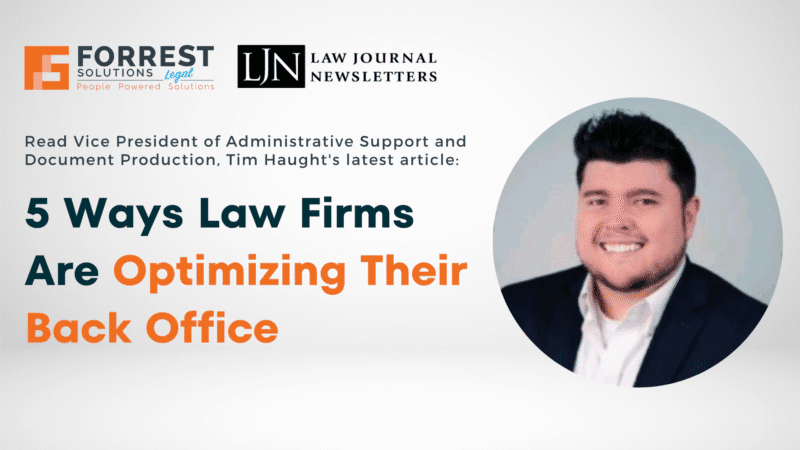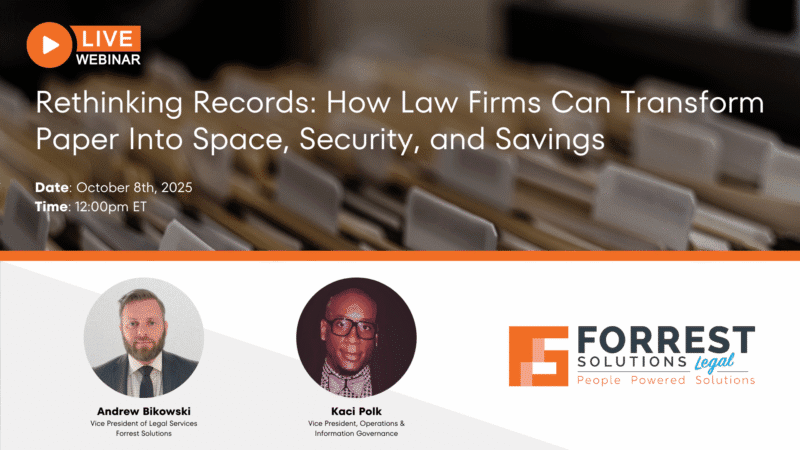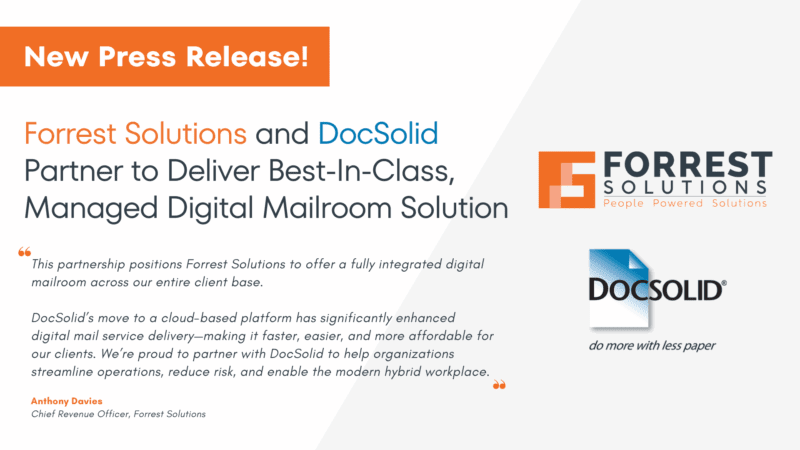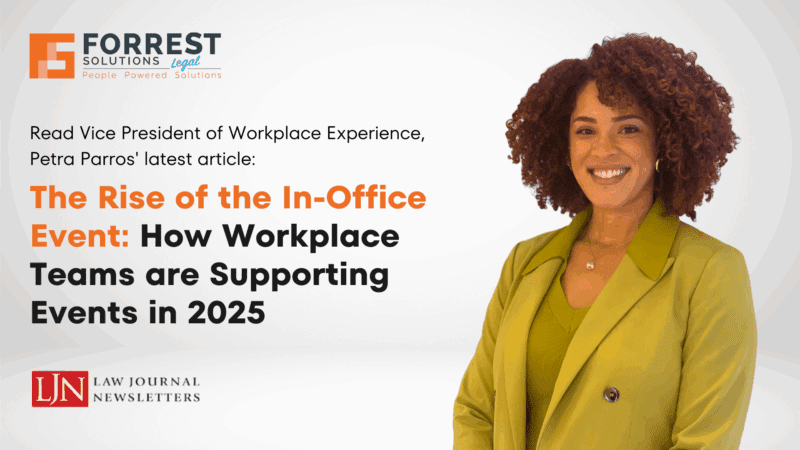
What Successful Hybrid Firms Are Doing
By Anthony Davies
This article originally appeared in Law.com here
March 2023 will mark the three-year anniversary of the onset of the coronavirus pandemic and the mandated closure of non-essential businesses. During the two-year span of work-from-home that ensued, law firms — for the most part — performed well financially, posting record profits.
The Main RTO Driver: People
But starting in late 2021, the drumbeat of “return-to-the-office” began and now — somewhere in the neighborhood of two years later of that — it begs the question: how are firms doing with their return-to-office? What is the market bearing? What “return-to-office” programs — if any — have been successful?
What we are seeing is a variety of successful measures that are designed to help attorneys get what they want: a best-of-both worlds scenario where they keep some work-from-home and fold-in an opportunity to intentionally connect and collaborate with colleagues in the office. They keyword is “intentional” but we’ll get to that in a moment.
This is good because, it turns out, what people want is to be with people. In a study cited by Thomson Reuters’ 2023 State of the Legal Market report (see, https://tmsnrt.rs/3D1j6Pu), Microsoft surveyed 20,000 people and analyzed trillions of Microsoft 365 productivity signals to determine what factors are most important in getting employees to return to their offices. The survey disclosed, perhaps not surprisingly, that the real value of the office is not the place but the people.
When asked what would motivate them to come into the office, the surveyed employees had a resounding answer — time with coworkers:
- 85% of employees would be motivated to go into the office to rebuild team bonds;
- 84% of employees would be motivated to go into the office if they could socialize with co-workers;
- 74% of employees would go to the office more frequently if they knew their “work friends” were there; and
- 73% of employees would go to the office more frequently if they knew their direct team members would be there.
This research strongly suggests that firm strategies designed around fostering connections among employees are likely to be more successful than more punitive approaches. There is evidence accumulating now that some firms are beginning to tie in-office attendance to job security and bonuses, a trend that could expand given the excess capacity that many firms currently have. However, the data suggests this may not be the best way to attract lawyers back.
What’s Working In Practice
We’ve long contended that the three main reasons anybody attends the workplace “in person” is to either connect, collaborate or focus. The pre-pandemic workplace was built for the latter, but given the focus is now on using the workplace primarily to focus on its people and the need to connect and collaborate, many law firms are re-thinking, redesigning and relocating the office to better serve these needs.
What we are seeing in practice runs the gamut, from mandated days in the office to 100% hoteling. In December 2023, we polled over 100 Am Law operations leaders during “The Post-Pandemic Law Firm: Frameworks for Success,” — a thought leadership virtual event we co-hosted — and nearly 40% of the attendees stated they had implemented a return-to-office (RTO) mandate.
Most of these firms had started with two to three days required in the office, with Tuesday/Wednesday being the most common “anchor” days. There have been challenges convincing certain groups back to the office, especially given the success of remote working over the last three years, but this hybrid model seems to strike the right balance in terms of pure “time” in the office, achieving the objectives of the firm without driving excessive attrition.
So, what are the key initiatives we have seen across our client base of Am Law 100/200 law firms? What is working, and what is still a work in progress?
- Real Estate: While some firms have elected to reduce space, many have re-utilized space, or even relocated their space to make it more attractive and accessible for its people. Floorplans have been redesigned to reflect the need for more connection and collaboration space. Many firms plan to relocate to locations better served by public transport, and some are even quitting leases early to do this.
- Hospitality: In my article “The Rise of Hospitality in Law Firms” from January 2022, I talked about how our professional services and advisory clients had established a new way of focusing in their people by turning to hospitality to attract and retain staff. Now it is clear law firms are following the same path, as they create workplace experiences with Ritz Carlton-like service and amenities. The workplace has to be a better experience than working from home to offset the time and inconvenience of the commute.
- Hoteling/Hot Desking: Paying for real estate that is not used is a waste but asking employees to come back to half empty offices is arguably worse when the objective of office time is to be with people. Hot desk floors are starting to appear in law firms, and a common theme is to make these the most desirable floors in the building. Added amenities, refreshments and events make these floors most attractive, and there is now a growing group of volunteers electing to give up their permanent desk.
- Technology: When we speak of the ‘intentionality’ of attorneys’ in-office time, this is something that is going to require technology. Coordinating reservable and shared space, locating colleagues, pre-ordering refreshments and reporting on office utilization lean heavily on the right technology. Room booking systems existed before Covid, but these technologies have evolved fast, giving employees increased control over their whole workplace experience.
- Digitization: Paper documents are particularly inconvenient for hybrid schedules. In the early days of the pandemic, records centers utilized curbside deliveries to get documents to partners’ homes. Increasingly, widescale scanning projects have now streamlined this process allowing lawyers to review documents electronically and securely wherever they decide to work that day. The paperless office is slowly becoming a necessity to support what attorneys want rather than a nicety.
- Incentive Programs: It started with free meals and snacks, but incentive programs have now become much more sophisticated. There are examples of firms rewarding in person work with benefits including better parking spaces, leisure vouchers or even increased bonus payments. Attending social and networking events are an especially important part of driving culture, so can now carry the biggest incentives.
- Outsourcing: Implementing many of these initiatives requires expertise and resources that are not core to law firm activities. Accessing these resources through a flexible outsourcing provider with expertise in talent, hospitality and technology has enabled many firms to drive their hybrid schedule forward much faster. Outsourcing also gives the added benefit of try before you buy with certain initiatives.
Conclusion
Hybrid is successful when firms focus on making people successful in the office. The modern workplace continues to play a crucially important role in collaborating and building culture and loyalty, and many firms have now found the right balance and experience to do this without driving employees away. I look forward to continued success building the optimum hybrid workplace experience.





